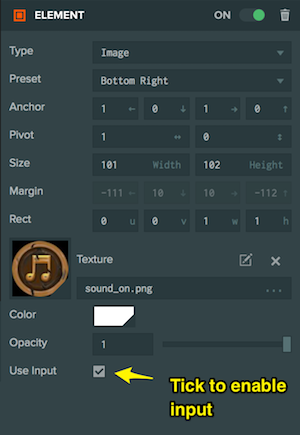Input
ユーザは、Elementコンポーネントの useInputフィールドを有効にすることで、Elementコンポーネントとインタラクトできます。

また、動作させるためには pc.Application#elementInputにpc.ElementInputのインスタンスを初期化しなければなりません。Editorを使用している場合は自動的に作成されます。Engineを使用している場合は、次のように、pc.Mouseやpc.TouchDeviceのような他の入力デバイスの前にインスタンスを作成してください:
const app = new pc.Application(canvas, {
elementInput: new pc.ElementInput(canvas),
mouse: new pc.Mouse(canvas),
touch: !!('ontouchstart' in window) ? new pc.TouchDevice(canvas) : null,
keyboard: new pc.Keyboard(window),
gamepads: new pc.GamePads(),
...
});
イベント入力
Elementコンポーネントで入力を有効にすると、次のイベントが発生します:
mousedown
マウスカーソルがコンポーネント上にある際にマウスが押されると発生します。
mouseup
マウスカーソルがコンポーネント上にある際ににマウスが離されると発生します。
mouseenter
マウスカーソルがコンポーネントに入ると発生します。
mouseleave
マウスカーソルがコンポーネントを離れると発生します。
mousemove
マウスカーソルがコンポーネント上に移動すると発生します。
mousewheel
コンポーネント上でマウスホイールがスクロールされると発生します。
click
コンポーネント上でマウスを押して離したとき、またはコンポーネント上でタッチが開始および終了したときに発生します。
touchstart
コンポーネント上でタッチが開始されたときに発生します。
touchend
コンポーネント上でタッチが終了すると発生します。
touchmove
コンポーネントに触れ始めた後にタッチが移�動したときに発生します。
touchcancel
コンポーネント上でタッチがキャンセルされたときに発生します。
Event Handling
入力イベントを処理するには、Elementコンポーネントでリッスンします。
this.entity.element.on('click', function (event) {
console.log('The element ' + event.element.entity.name + ' was clicked.');
}, this);
Event bubbling
Elementコンポーネントで入力イベントが発生すると、 event.stopPropagation()を呼び出さない限り、親要素にバブルアップします。 例えば:
this.entity.element.on('click', function (event) {
// stop bubbling
event.stopPropagation();
console.log('The element ' + event.element.entity.name + ' was clicked.');
}, this);
stopPropagationを呼び出すと、イベントが pc.Mouseや pc.TouchDeviceのような他の入力デバイスによって処理されなくなります。たとえば、app.mouse.wasPressedを使ってマウス入力を処理している場合、mousedownイベントで stopPropagationを呼び出してapp.mouse.wasPressedがtrueを返さないようにします。 例えば:
var InputScript = pc.createScript('inputScript');
InputScript.prototype.initialize = function () {
this.entity.element.on('mousedown', function (evt) {
evt.stopPropagation();
}, this);
},
InputScript.prototype.update = function (dt) {
if (this.app.mouse.wasPressed(pc.MOUSEBUTTON_LEFT)) {
// do something when the left button was pressed.
// this will not be called if the button was pressed on the Element
// because we call stopPropagation
}
}
Google Chromeのマウスとタッチイベントの競合
Google Chromeは、タッチデバイスでもマウスイベントをシミュレートします。そのため、予期しない動作が発生する可能性があります。たとえば、クリックイベントの直後にボタンを非表示にすると、その後ろにある別のUI要素も望ましくないクリックイベントを受信する可能性があります。
この動作を防止するには、pc.EVENT_TOUCHENDイベントのネイティブイベントオブジェクトのpreventDefault()メソッドを呼び出すことができます。
次に、シーンに一度含める小さなスクリプトです。
var TouchFix = pc.createScript('touchFix');
// initialize code called once per entity
TouchFix.prototype.initialize = function() {
// Only register touch events if the device supports touch
const touch = this.app.touch;
if (touch) {
touch.on(pc.EVENT_TOUCHEND, function(event) {
// This prevents that a mouse click event will be executed after a touch event.
event.event.preventDefault();
});
}
};